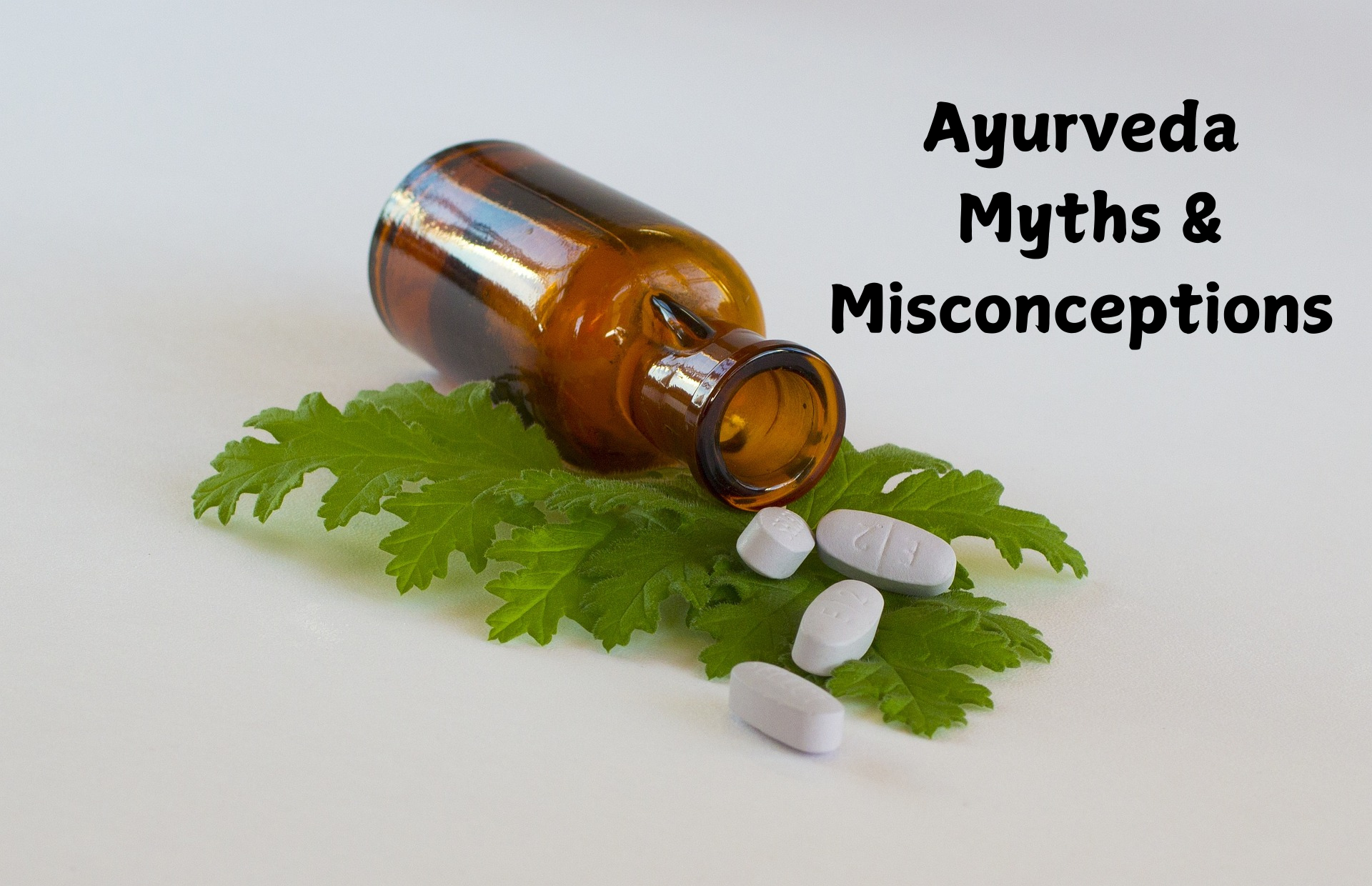Ayurveda, the ancient Indian system of medicine, has been practiced for over 5,000 years. It emphasizes a holistic approach to health, focusing on balancing the mind, body, and spirit. In recent years, Ayurveda has gained global popularity as people seek natural and sustainable ways to improve their well-being.
However, with its rise in popularity, Ayurveda Myths and Misconceptions also emerged. These misunderstandings can lead to confusion and even misuse of this profound healing system. In this blog post, we’ll debunk some of the most common Ayurveda myths and provide clarity on what this ancient science truly stands for.
Table of Contents
Myth 1: Ayurveda is Just About Herbal Remedies
One common misconception is that Ayurveda is solely about herbal treatments and remedies. While herbal medicine is indeed a crucial aspect of Ayurvedic healing, it represents only one part of this comprehensive system of natural health care.
What Ayurveda Really Encompasses:
Preventive Health: Ayurveda focuses on prevention rather than just curing illnesses. By following the principles of Ayurveda, individuals can prevent diseases from occurring in the first place through diet, balanced routines, and stress reduction techniques.
Holistic Approach to Health: Ayurveda is a holistic system that focuses on achieving balance in the body, mind, and spirit. It includes a wide range of practices, such as:
Diet: Personalized dietary recommendations based on your dosha (constitution) to promote optimal digestion and overall well-being.
Lifestyle: Daily routines (known as “Dinacharya”) that involve activities like waking up early, mindfulness, exercise, and proper sleep to maintain balance.
Exercise: Yoga, specific to one’s constitution, is a significant part of Ayurveda for maintaining physical and mental health.
Meditation: To calm the mind and enhance mental clarity, reducing stress and fostering inner peace.
Detoxification: Practices like Panchakarma (Ayurvedic detox therapies) aim to remove toxins from the body and rejuvenate health.
Emphasis on Mind-Body Balance: Ayurveda emphasizes the interconnectedness of the body and mind. It goes beyond treating symptoms and seeks to understand the underlying causes of imbalances. Stress management, mindfulness, and mental health are as important as physical health in Ayurveda.
Individualized Treatments: Treatments in Ayurveda are highly personalized and go beyond just herbs. Based on your unique dosha and imbalances, an Ayurvedic practitioner may recommend changes in diet, lifestyle adjustments, specific yoga practices, and more, in addition to herbs.
Myth 2: Ayurveda is Slow and Ineffective
Another common misconception is that Ayurveda is slow and ineffective compared to modern medical treatments. While Ayurvedic treatments may take time to show results in some cases, this belief overlooks the fundamental differences between how Ayurveda and conventional medicine approach health and healing.
Why This Myth Exists:
- Focus on Long-Term Healing: Ayurveda focuses on treating the root cause of an illness, not just alleviating symptoms. This process may take longer compared to conventional treatments that focus on quick symptom relief. However, addressing the root cause often leads to more sustainable and long-lasting health benefits.
- Chronic Conditions: People with chronic conditions often expect immediate relief, which might lead to the perception that Ayurveda is slow. However, Ayurveda’s goal is to restore balance over time and prevent future imbalances, making it highly effective in managing chronic conditions when approached with patience.
Why Ayurveda Is Not Ineffective:
Fewer Side Effects: Ayurvedic treatments rely on natural herbs, dietary adjustments, and lifestyle changes, which typically have fewer side effects compared to conventional medications. This slower, gentler approach allows the body to heal itself without the risk of harsh reactions.
Holistic Healing: Ayurveda treats the whole person, considering physical, mental, emotional, and spiritual health. It aims to bring the body back into balance through natural means, resulting in long-term well-being rather than quick fixes. The therapies may take time because they aim for deeper, systemic healing, but the results are often more sustainable.
Personalized Treatment: Ayurvedic treatments are tailored to the individual’s unique constitution (dosha) and imbalances. Because treatments are not “one-size-fits-all,” they are more effective in addressing the specific needs of the person. When properly followed, the results can be profound and lasting, especially for chronic issues.
Preventive Approach: Ayurveda is preventative in nature, aiming to maintain balance in the body and prevent illness. By following Ayurvedic lifestyle recommendations, such as diet and daily routines, many individuals can avoid diseases before they occur. This approach may not offer instant results, but it is highly effective in promoting long-term health.
Effective for Chronic Conditions: Ayurveda is particularly effective in managing chronic conditions such as arthritis, digestive disorders, skin issues, and stress-related illnesses. While the results may take longer compared to pharmaceutical treatments, the relief is often more enduring because it treats the root cause of the condition.
Myth 3: Ayurveda is Only for Indians or Followers of Hinduism
Some people believe that Ayurveda is exclusive to Indian culture or Hinduism and cannot be practiced by people from other backgrounds. This myth limits the global reach and understanding of Ayurveda as a universal science of life.
Fact: Ayurveda is a universal system of medicine that transcends cultural and religious boundaries. Its principles are based on natural laws and can be applied by anyone, regardless of their ethnicity or beliefs. The focus is on understanding one’s unique constitution (Prakriti) and making lifestyle choices that promote balance and harmony.
Myth 4: Ayurveda is Completely Safe Because It’s Natural
Many people assume that Ayurveda is 100% safe simply because it uses natural ingredients. This misconception can lead to the misuse of Ayurvedic remedies, such as self-prescribing herbs or supplements without proper guidance.
Fact: While Ayurveda is rooted in nature, it’s not without risks if used incorrectly. Certain herbs can have side effects or interact with medications. For example, ashwagandha, a popular Ayurvedic herb, may not be suitable for individuals with hyperthyroidism or autoimmune conditions. It’s crucial to consult a qualified Ayurvedic practitioner before starting any treatment.
Myth 5: Ayurveda Rejects Modern Medicine
Some people believe that Ayurveda and modern medicine are mutually exclusive and that practicing Ayurveda means rejecting conventional treatments. This myth can prevent individuals from seeking the best of both worlds.
Fact: Ayurveda and modern medicine can complement each other. While Ayurveda focuses on prevention and holistic healing, modern medicine excels in acute care and advanced diagnostics. Integrative approaches that combine the strengths of both systems are increasingly being recognized as effective for overall health.

Myth 6: Ayurveda is Only About Diet and Lifestyle
While diet and lifestyle are central to Ayurveda, some people mistakenly believe that these are the only aspects of this ancient science. This misconception overlooks the depth and diversity of Ayurvedic practices.
Fact: Ayurveda includes a wide range of therapies, such as massage (Abhyanga), oil treatments (Shirodhara), detoxification (Panchakarma), and even surgical techniques. It also emphasizes mental and emotional well-being through practices like meditation and pranayama (breath control).
Myth 7: Ayurveda is a One-Size-Fits-All Approach
Another common myth is that Ayurveda offers the same remedies for everyone, regardless of their individual needs. This misconception can lead to ineffective or even harmful practices.
Fact: Ayurveda is highly personalized. It recognizes that each individual has a unique constitution (Prakriti) and set of imbalances (Vikriti). Treatments and recommendations are tailored to suit the specific needs of the person, making it a truly individualized system of medicine.
Myth 8: Ayurveda is Only for Physical Health
Many people associate Ayurveda solely with physical health, overlooking its profound impact on mental and emotional well-being.
Fact: Ayurveda places equal importance on mental and emotional health. Practices like meditation, yoga, and the use of calming herbs like Brahmi and Ashwagandha are integral to Ayurvedic treatments for stress, anxiety, and depression.
Myth 9: Ayurveda is Outdated and Not Scientifically Valid
Some critics argue that Ayurveda is an outdated system with no scientific basis. This myth undermines the growing body of research supporting Ayurvedic principles and practices.
Fact: Modern science is increasingly validating Ayurveda. For example, studies have confirmed the anti-inflammatory properties of turmeric and the stress-reducing effects of Ashwagandha. While more research is needed, Ayurveda’s holistic approach is gaining recognition in the scientific community.
Myth 10: Ayurveda is Expensive and Inaccessible
There’s a misconception that Ayurveda is only for the wealthy or those who can afford expensive treatments and retreats.
Fact: Ayurveda can be practiced at home with simple, affordable changes to diet and lifestyle. Many Ayurvedic remedies use everyday ingredients like ginger, turmeric, and honey, making them accessible to people from all walks of life.
How to Approach Ayurveda Wisely
Ayurveda, an ancient system of natural healing that originated in India over 5,000 years ago, focuses on achieving balance in the body, mind, and spirit. Although Ayurveda offers numerous health benefits, it’s essential to approach it wisely and thoughtfully, especially if you’re new to this holistic system. Here are some key guidelines for approaching Ayurveda safely and effectively:
1. Understand Your Dosha
In Ayurveda, each person is believed to have a unique constitution, or dosha, which is a combination of three energies: Vata (air), Pitta (fire), and Kapha (earth and water). Understanding your dominant dosha is key to personalizing your Ayurvedic practices and lifestyle.
- How to Discover Your Dosha:
- Consult with an Ayurvedic practitioner for a detailed analysis.
- Take a dosha quiz to get a general understanding of your constitution.
Each dosha has specific physical and emotional characteristics, and imbalances in your dosha can lead to health issues. Once you understand your dosha, you can adopt lifestyle practices that help restore balance.
2. Consult a Qualified Ayurvedic Practitioner
While there is plenty of online information about Ayurveda, the best approach is to consult a trained Ayurvedic practitioner. They can provide personalized guidance based on your health history, current concerns, and dosha constitution.
- Why Consult a Practitioner:
- A practitioner can help you identify the root cause of imbalances and recommend the right treatments.
- They can ensure that the herbs, therapies, and lifestyle changes are tailored to your unique needs.
- You’ll receive proper dosages for herbal treatments, ensuring safety.
3. Start with Simple Changes
Ayurveda offers a wide array of practices, from diet and herbal remedies to yoga and meditation. It’s best to start with small, manageable changes and gradually incorporate more Ayurvedic principles into your life.
- Simple Practices to Begin With:
- Morning routine: Start your day with a glass of warm water, which helps with digestion and detoxification.
- Tongue scraping: This is an easy Ayurvedic practice for oral hygiene and removing toxins.
- Herbal teas: Incorporate Ayurvedic herbal teas like ginger or tulsi (holy basil) into your daily routine to support digestion and immune health.
4. Focus on Diet According to Your Dosha
Ayurveda emphasizes the importance of diet in maintaining health. Each dosha thrives on different types of foods, so it’s essential to follow a diet that supports your constitution.
- Vata: Warm, moist, and grounding foods like soups, stews, and root vegetables. Avoid raw, cold, and dry foods.
- Pitta: Cooling, calming foods like fresh fruits, vegetables, and whole grains. Avoid spicy, sour, and salty foods.
- Kapha: Light, warm, and stimulating foods like green vegetables, legumes, and spices. Avoid heavy, oily, and sugary foods.
5. Be Mindful of Ayurvedic Herbs and Supplements
Ayurvedic herbs are potent and powerful, offering a wide range of benefits. However, it’s important to be cautious, especially if you’re unfamiliar with them or taking medications for other health conditions.
- Common Ayurvedic Herbs:
- Ashwagandha: Supports stress reduction and overall vitality.
- Turmeric: Known for its anti-inflammatory properties.
- Triphala: Promotes digestion and detoxification.
- Precautions:
- Always consult a healthcare provider before starting any Ayurvedic herbs or supplements, especially if you are pregnant, nursing, or taking medication.
- Use high-quality, organic supplements to avoid contaminants.
- Follow proper dosages, as Ayurvedic herbs are concentrated and powerful.
6. Practice Mindfulness and Meditation
In Ayurveda, mental and emotional well-being are just as important as physical health. Incorporating mindfulness practices like meditation, pranayama (breathing exercises), and yoga into your daily routine can help you achieve a balanced mind and spirit.
- Mindfulness Tips:
- Start with just 5-10 minutes of meditation a day to reduce stress and improve focus.
- Practice deep breathing exercises (such as Nadi Shodhana or alternate nostril breathing) to balance your nervous system and manage anxiety.
- Incorporate yoga poses that align with your dosha (e.g., grounding poses for Vata, cooling poses for Pitta, and invigorating poses for Kapha).
7. Follow Seasonal Routines
Ayurveda emphasizes living in harmony with nature and the changing seasons. Each season has a dominant dosha, and adapting your diet and lifestyle to the season can help prevent imbalances.
- Seasonal Tips:
- Vata Season (Fall/Winter): Focus on warming, grounding foods and stay warm and moisturized.
- Pitta Season (Summer): Opt for cooling foods like cucumber and coconut, and stay hydrated.
- Kapha Season (Spring): Eat light, warm, and spicy foods to balance Kapha’s heaviness, and engage in vigorous exercise.
8. Avoid Extremes
Ayurveda is about balance, and it’s important to avoid extreme dietary changes, exercise regimens, or detoxes that could create further imbalances in the body. Gradual changes and moderation are key.
- Tip: If you’re considering a Panchakarma (Ayurvedic detox), consult a practitioner to ensure it’s done safely and appropriately for your body type.
9. Listen to Your Body
Ayurveda teaches you to tune into your body’s signals and adjust your lifestyle accordingly. Symptoms like digestive issues, skin problems, or fatigue may indicate an imbalance that needs to be addressed.
- Tip: Pay attention to how different foods, activities, and environments affect you. Adjust your routine as needed to maintain balance.
10. Be Patient
Ayurveda is not a quick-fix system but rather a holistic approach that promotes long-term health. It may take time to see results, especially if you are working to restore balance in a deeply rooted health issue. Be patient, and embrace the gradual healing process.
Conclusion
Ayurveda is a timeless science that offers profound insights into health and well-being. However, like any system of medicine, it’s essential to separate fact from fiction. By debunking these common Ayurveda myths and misconceptions, we can better appreciate the depth and wisdom of this ancient practice. Whether you’re new to Ayurveda or a seasoned practitioner, approaching it with clarity and respect will help you unlock its true potential for a balanced and harmonious life.
By addressing these myths, we hope to provide a clearer understanding of Ayurveda and inspire you to explore its benefits with confidence. Remember, Ayurveda is not just a system of medicine—it’s a way of life. Embrace it wisely, and let it guide you toward holistic health and well-being.

